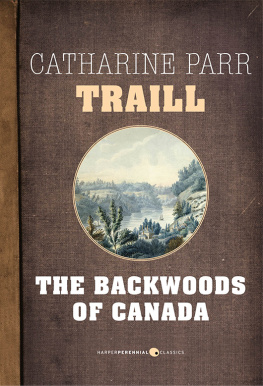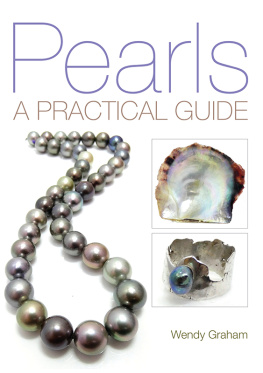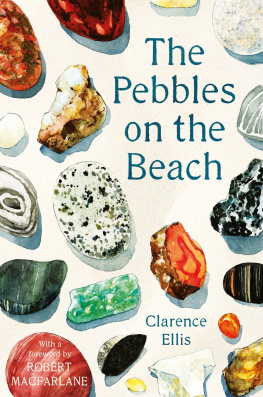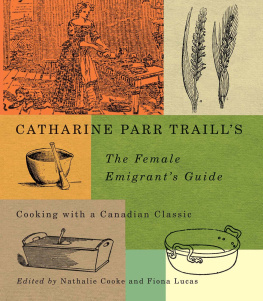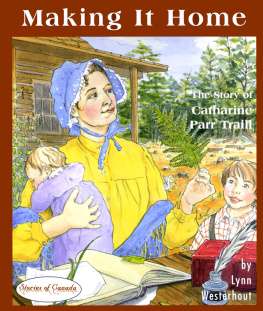PEARLS & PEBBLES

Catharine Parr Traill

PEARLS & PEBBLES
Edited by
Elizabeth Thompson

Copyright 1999 by Elizabeth Thompson
All rights reserved. No portion of this book, with the exception of brief extracts for the purpose of literary or scholarly review, may be reproduced in any form without the permission of the publisher.
Published by Natural Heritage/Natural History Inc.
P.O. Box 95, Station O, Toronto, Ontario M4A 2M8
Frontispiece: Yours Very Sincerely, Catharine Parr Traill, from Pearls and Pebbles (1894).
Back cover photo: Catharine Parr Traill (18021899) with two of her granddaughters, Ston[e]y Lake, Ontario, Circa 1850.
Design by Blanche Hamill, Norton Hamill Design Printed and bound in Canada by Hignell Printing Limited
Canadian Cataloguing in Publication Data
Traill, Catherine Parr, 18021899
Pearls and pebbles
Includes bibliographical references and index.
ISBN 1-896219-59-4
1. Natural historyOntario. I., Thompson, Elizabeth Helen, 1952II. title.
QH81.T82 1999 508.71 C99-931716-4

Natural Heritage/Natural History Inc. acknowledges the support received for its publishing program from the Canada Council Block Grant Program. We also acknowledge with gratitude the assistance of the Association for the Export of Canadian Books, Ottawa.
This book is dedicated to Margaret Phyllis Thompson: writer., researcher, and colleague.
ACKNOWLEDGMENTS
I would like to thank Karen Kingsmill for her research assistance and for her encouragement.
CONTENTS
EDITORS INTRODUCTION

ABOUT THE AUTHOR, CATHARINE PARR TRAILL
CATHARINE Parr (Strickland) Traill was born in England in 1802, and grew up in Suffolk. She was the fifth of eight children in a middle-class familyseveral of whom became well-known writers, two examples being Agnes Strickland, Lives of the Queens of England (1840-1848) and Susanna Moodie, Roughing It in the Bush (1852) Catharine began writing while she was very young, publishing The Tell Tale: An Original Collection of Moral and Amusing Stories (1818) when she was only sixteen. During her teens and twenties, Catharine continued to write: moral childrens tales, books about nature and natural history, as well as poems and sketches that she contributed to English periodicals. Her family, left in a precarious financial position by the death of Catharines father, Thomas Strickland, in 1818, welcomed her assistance, meager though it might be.
In May 1832 Catharine married Thomas Traill, a half-pay officer in the British army. Deciding that they could not support a family on his income, and hoping for improved circumstances in the New World, in July 1832, the couple set sail for Upper Canada (now Ontario). Like many middle-class English emigrants, the Traills were unprepared, mentally or physically, for backwoods life and encountered countless unforeseen difficulties. Although the anticipated prosperity never materialized, as a writer, Catharine Traill capitalized on her pioneer experiences, publishing such non-fiction Canadian classics as The Backwoods of Canada (1836) and The Canadian Settlers Guide (1854); lively and pragmatic, these books were popular at the time and are still widely-read today.
Catharine Traills life in Canada affected her fiction as well, for in Catherine Maxwell, the protagonist of Canadian Crusoes (1852), she creates the prototype for a heroine who can be found in Canadian fiction up to and including the present: a practical, capable pioneer woman who survives, even thrives on a hostile frontier. Traills definition of the ideal frontiers woman represents a significant contribution to Canadian literature.
An inveterate scribbler, Traill was still writing when she was in her nineties, publishing Pearls and Pebbles in 1894 and Cot and Cradle Stories in 1895. Pearls and Pebbles represents a culmination of sorts, for in it Traill has collected sketches written throughout her life, featuring, but not limited to her knowledge of Canada. Near the end of the century, and almost a century old herself, Traill looks back to reflect on her life and on Canadian pioneering; she looks around her and observes her contemporary landscape; and she looks ahead to the twentieth century, predicting further changes in the place she loves.
Nor was Traill finished here. Cot and Cradle Stories, a collection of childrens stories, appeared the following year, and as her journals make clear, she had further work in mind. Her pen was stilled only by her death in 1899but through her lively and timeless writing, the spirit of the woman lives on.
ABOUT THE BOOK
It is hard to believe that Catharine Traills Pearls and Pebbles was published over one hundred years ago, for its captivating charm goes beyond one particular time and place; indeed it reaches out to us today with undiminished vigour. While a good deal of the books joie de vivre stems from the warm, vibrant speaking voice of the author, the books varietyin content, shape, and styleis also fascinating. It is a miscellany, or to use Traills analogy, a collection of pearls and pebbles:
...if you glean but one bright glad thought from the pages of my little volume, or add but one pearl to your store of knowledge from the experience of the now-aged naturalist, she will not think the time has been wasted that has been spent in gathering the pebbles from notebooks and journals written during the long years of her life in the backwoods of Canada.
The book consists of a series of prose sketches, and some poetry. The chief focus is Canadian natural history: native flora and fauna as Traill observes them in the 1890s; as they were in the 1830s when she came to Canada; and as they may become in the next century. But her topic is not limited to the environment, and several chapters describe pioneer life in Upper Canada. Moreover, within chapters, topics frequently overlap, so that a single sketch becomes a tapestry of interwoven textual strands. Stylistically too, miscellany rules as Traill mingles meditation, anecdote, reminiscence, and detached scientific observation. Although Traills voice controls the work, other voices are heard, both in the frequent citations of poetry and prose and in the inclusion of other speakers, as in the female narrator of Alone in the Forest. The result is a multi-faceted, never-dull volume with a broad appeal, certain to be as popular now as it was over a century ago.
One of the many facets of Pearls and Pebbles is its autobiographical quality; it provides details of Traills lifeand encompasses ninety years of that life! The book opens with Pleasant Days of My Childhood, a reflective, nostalgic reminiscence of the Strickland familys celebration of May Day, long ago in England. Pleasant Days sets forth the authors love for her family, a bond that was maintained by letters, even when Catharine had emigrated to Canada. And in Canada, the other two Strickland emi-grants, Susanna Moodie and Samuel Strickland, were always in close contact with their sister Catharine. In addition, the first chapter establishes Catharines position as a family favourite, an especial pet in the house-hold. As the biographical introduction to the first edition makes clear, Catharine, the cheerful loving child, kept the qualities that endeared her to others into adulthood and old age. In her interesting and anecdotal biography of Catharine Traill, Mary Agnes FitzGibbon involves a few of her great-aunts many admirers including in the number, such pre-eminent figures as Sandford Fleming, later to be knighted for his achievements and become Sir Sandford Fleming. Traill might have lacked money, but she certainly never lacked friends!
Next page

